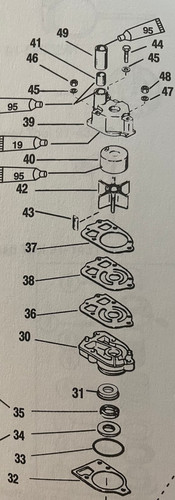Signs Your Outboard’s Water Pump is Bad
- Felicia Lambert
- Apr 24
- 4 min read

As a boat owner in South Florida, maintaining your boat engine not only matters, but it involves more than having only your annual service done. When you're cruising out on the water, it’s important that you pay attention to how your engine is performing. If you hear unusual noises or notice it isn't running at its best, these could be signs that something is starting to fail.
One crucial component that can fail without obvious signs is the water pump.
What is an Outboard Water Pump?
The water pump in your outboard is a crucial part that helps maintain your engine's temperature, especially for those who enjoy boating in South Florida. Situated in the lower unit and driven by the drive shaft, it pulls water from the ocean, river, or lake and circulates it through the engine to keep it cool. The pump's key component is a rubber impeller, resembling a rotating fan, which aids in moving water through the engine's cooling system.
Over time, your impeller can wear out, particularly if it is exposed to sand, salt, or mud, or if it experiences dry starts. If the impeller fails, the cooling system will stop functioning, and your engine could overheat within minutes. This highlights the importance of being able to identify signs of a failing water pump before it completely fails, which can lead to engine overheating, damage, and costly repairs.
In this article, we will help you identify signs to determine if your outboard water pump is malfunctioning as well as key signs to look for that indicate it has failed.
Key Signs of a Bad Water Pump
Below are the most common signs that your outboard’s water pump is failing:
1. Overheating Engine
One of the first and most serious signs that your water pump is bad is if your engine is overheating. If your engine temperature rises quickly or reaches high levels, check the cooling system right away. Overheating can not only cause damage like failed gaskets or warped engine parts, but it could also cause your engine could break down altogether.
If you have a newer outboard motor, it will have temperature sensors and alarms. Frequent alerts are also a sign that your water pump impeller is wearing out or has failed completely.
2. Weak Stream
Every outboard has a telltale ( a small outlet) where water shoots out once your engine is on and running. This is a visual indicator that water is flowing through your engine properly. If the stream becomes weak, intermittent, or if it completely stops, it's a strong sign that your water pump isn't circulating enough water.
Remember to look for clogs in your telltale outlet. You should first check for any debris, salt buildup, or mud in the hole. If the stream is still weak after cleaning, it’s time to inspect the pump.
3. Steam or White Smoke from the Exhaust
Your outboard engine should never produce steam or white smoke. If you notice thick vapors or white smoke coming from your outboard's exhaust, this indicates water is not reaching the exhaust system to cool it down. This situation is often caused by a damaged or failing water pump impeller.
4. Burning Rubber Smell
Does your outboard engine smell like burning rubber? This is another warning sign that your rubber impeller might be running dry or rubbing against a damaged housing. If the impeller has deteriorated or isn’t spinning properly, the resulting friction can generate heat, leading to a noticeable burning smell.
5. Strange Noises
Is your lower unit making a high-pitched or squealing noise? This, too, may indicate that your impeller is damaged or seized. This is particularly common in motors that have been stored for long periods without use. If you start up your engine without running water, you risk damaging the impeller in seconds, which can lead to these strange noises.
6. Decreased Performance
Your outboard motor is designed to reduce power output when temperatures reach dangerously high levels as a safety feature. If your engine is struggling to start, stalling, or entering limp mode, it may be trying to protect itself from overheating. A decreased outboard performance does not always mean a fuel issue; you should also check your engine’s cooling system.
How Often Should You Replace Your Outboard Water Pump?
As a rule of thumb, most marine mechanics recommend replacing your water pump impeller every 2 to 3 years—or more frequently if you boat in shallow, sandy, or salty environments. If you use your outboard heavily or store it for long periods between seasons, yearly inspections are smart.
Even if the impeller isn’t completely worn out, rubber hardens and cracks over time, reducing its effectiveness. Maintenance matters, and it is more cost-effective to inspect or replace them than it is to replace a blown head gasket or cracked engine block due to overheating.
Seeking Professional Outboard Water Pump Service
It's important to pay attention to the warning signs of a water pump failure, such as overheating, weak water flow, steam, or unusual smells. If you address these issues right away, you can help prevent serious engine damage from occurring. If you believe your water pump is failing, be sure to shut down the engine and investigate the problem.
Maintenance matters, and it can help keep your boat running smoothly and allow you to enjoy worry-free days on the water. If you're not confident in diagnosing the water pump yourself, call The Mobile Mariner. We are here to give you the peace of mind on the water so you can cruise confidently.










Comments